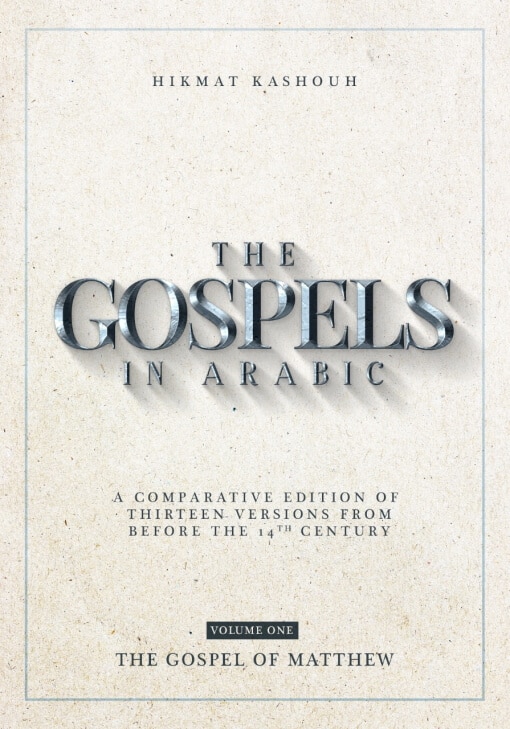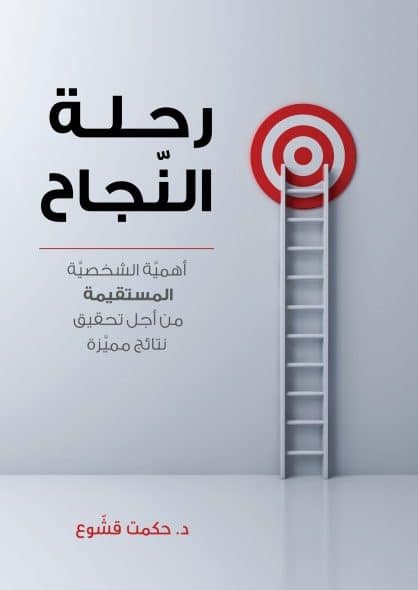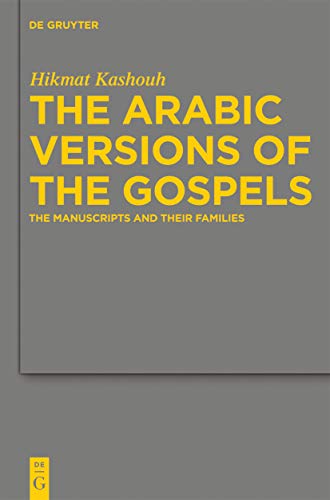By Hikmat Kashouh
The Gospels in Arabic
Volume One
This book is a comparative edition of the Gospel of Matthew in Arabic. The first part of this volume gives a description of thirteen different versions of the Gospels in Arabic, from as early as the seventh century until the thirteenth century A.D. The second part of the book presents a concise study of the earliest extant Arabic Gospel text, in which the author argues, using new evidence, that the first translation of the Gospels was not produced in the Holy Land monastic communities between 685-735 A.D. from a Greek translation, but rather that the Gospels were translated earlier, in either Al-Hīra, Irāq, or Najrān, from an old Syriac text sometime between 500 and 620 A.D. The third part of the book presents these thirteen different Arabic versions of the Gospel of Matthew side by side in order that this part may be used as a comparative tool for in-depth study. Once published, scholars, pastors, and students will be able to access the desired texts of the Gospel of Matthew in Arabic, simultaneously and all in one place. This volume is over thirteen hundred pages, and is the first volume in a series of four volumes covering the four Gospels.
Have a look inside the book
Scholar Pastor Husband Father
Hikmat Kashouh
Hikmat Kashouh, is a published scholar with a PhD in Editing Texts in Religion from the University of Birmingham, UK. His book The Arabic Versions of the Gospels: The Manuscripts and Their Families, published by De Gruyter in 2012 is a foundational work and has helped many orientalists and scholars better understand the Arabic Christian tradition. Dr. Kashouh is an adjunct research professor at the Arab Baptist Theological Seminary, and the senior pastor of Resurrection Church, Beirut. He and his wife Krista have three children.
Published Books
Inquisitive Readers
Other Books
by the author
رحلة النّجاح
تذكّر قارئي العزيز أنّ العالم لا يتبع مشاريع مجرّدة، ولا أفكاراً جيّدةً، ولا تلهمه القضايا الاجتماعية أوّلاً، بل أفرادٌ، وأناسٌ، وقادةٌ يمتلكون شخصيات مميّزة، وملهمون بقضايا ومشاريع وأفكارٍ خلّاقةٍ. أقوى سلاح تمتلكه
رحلة الزواج الناجح
ينقل لك هذا الكتاب رسالة أمل صادقة، نابعة من خبرة الكثيرين، مضمونها أنّ الزواج مشروع الله للإنسان، ورحلة عمر متوّجة بالحبّ، أساسها الرغبة المخلصة، والسعي المتواصل، والأمانة، والدفع، والاحترام المتبادل
رحلة التربية الناجحة
إنّ طبيعة الحياة السريعة وتحدّياتها غير المتناهية، تردّي الوضع الاقتصاديّ الذي أوجب على الزوجين الانغماس في ساعاتٍ طويلة من العمل لتأمين مستلزمات الأسرة، جعلت من التربية مهمّة صعبة. وفي ظلّ انتشار الإنترنت ومواقع التواصل الاجتماعي والهواتف الذكيّة، أضحى الآباء يتخوّفون أكثر فأكثر من أن يتأثّر أولادهم بالفساد المنتشر في المجتمع.
درب إتباع المسيح
تأمل معي في هذا التلميذ المؤمن بيسوع، الذي تحول بفعل الانجذاب الكامل نحو سيده ومخلصه، حتى غدا يسوع وحده اهتمامه الأقصى هذا التلميذ نال من سيده، عند إيمانه، أعظم عطية، عطية الروح القدس السّاكن فيه
Following Jesus in Turbulent Times
Nations are haemorrhaging refugees around the world. How displaced peoples are treated is under constant scrutiny– whether in the UK, the USA, and Australia, or Turkey, Colombia, and Uganda.
How will the Church respond in these turbulent times?
ARABIC VERSIONS OF THE GOSPELS
This book is concerned with the Arabic versions of the Gospels. It is an attempt to examine a substantial number of Arabic manuscripts which contain the continuous text of the canonical Gospels copied between the eighth and the nineteenth centuries and found in twenty-one different library collections in Europe and the Orient.







